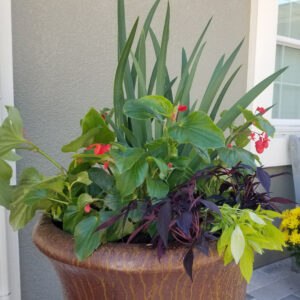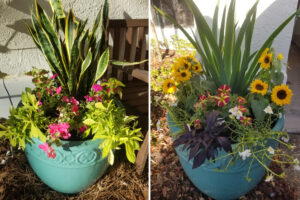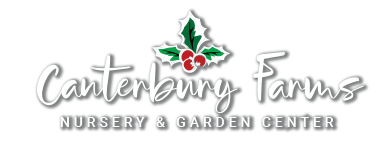By: Anna Stubbendick, FCHP
Container gardening is a great way to bring life and color to your landscape. Whether you have a large yard or a small balcony, container gardening can be a satisfying and rewarding experience. To create a beautiful container garden that thrives in our area, consider the following factors when selecting a pot, location, soil, and plants.

You can use the weight of ceramic planters to your advantage if you’re using a tall plant that might get a little top-heavy. This planter, designed for a sunny location uses Apostle Iris, Begonia, and two varieties of Sweet Potato Vine. Photo by Anna Stubbendick, Canterbury Farms
Choosing the Right Pot:
Selecting the right pot is crucial for the health and growth of your plants. The pot should be at least twice the size of your plant’s root ball. It’s also important to consider the material of the pot. In Central Florida’s hot and humid climate, choose pots made from materials that won’t retain too much heat, such as plastic or glazed ceramic. Avoid using unglazed terra cotta pots as they can dry out too quickly. Plastic pots are also much lighter in weight, which can be an advantage if you are needing to move sensitive tropical plants indoors during the cooler months.
Choosing the Right Location:
When selecting a location for your container garden, aesthetic considerations are just as important as practical ones. Choose a spot that is visually appealing and matches the style of your home. Consider the color and texture of the pot, as well as the plants that you will be using.
Most plants require a minimum of six hours of direct sunlight per day. Choose a location that receives adequate sunlight, such as a south or west-facing window, balcony, or patio. If your space is limited, consider using hanging planters or window boxes to maximize sunlight exposure. If your area is a shadier location, or inside a screened enclosure, there are many tropical plants that are also well-suited to areas with lower light levels.
Choosing the Right Soil:
High-quality potting mix is essential for the health of your plants. Choose a mix that contains peat moss, vermiculite, and perlite, which provide the necessary drainage and aeration your plants need. Avoid using soil from your yard, as it can contain pests, diseases, and weed seeds.

You can change the look of your planter just by using different plants. Here are two containers designed for different conditions, one for sun and one for shade. Photos by Anna Stubbendick, Canterbury Farms
Choosing the Right Plants:
When selecting plants for your container garden, consider using plants that are native to our area, such as firebush, coontie, and dwarf yaupon holly. These plants are well-suited to the warm and humid climate and can thrive in a container garden. Other plants that do well in zone 9b include tropical plants such as bromeliads, crotons, and palms.
To create a visually appealing container garden, use the “thriller, filler, spiller” approach when selecting plants. Choose one focal plant as the “thriller,” such as a tropical hibiscus or a bird of paradise. Surround it with several plants to fill in around it, such as pentas, coleus, or impatiens. Finally, add trailing plants to spill over the edge of the pot, such as creeping jenny or sweet potato vine.
How to Plant:
When planting in a container, start by filling the pot with potting mix, leaving enough space at the top for your plants. Gently remove your plants from their nursery containers and loosen the roots. Place the focal plant in the center of the pot and surround it with the filler plants. Finally, add the spiller plants around the edge of the pot, allowing them to drape over the side. Once all of the plants are in place, you can backfill with additional potting mix to fill the planter.
When planting, be sure to consider the aesthetic elements of your container garden. Mix different textures and colors for a visually interesting display. Use tall plants to create a vertical element, and mix in different types of foliage for added interest.
Watering and Maintenance:
Proper watering is crucial for the health of your container garden in Central Florida’s warm and humid climate. Water your plants deeply and regularly, allowing the soil to dry out slightly between watering. Avoid getting water on the foliage, as this can lead to disease. Keep in mind that container gardens will dry out faster than plants in the ground, so you may need to water every day during the drier seasons.
Fertilize your plants regularly with a balanced fertilizer, following the instructions on the label. Remove dead leaves and spent flowers to encourage new growth. Monitor your plants for signs of pests and disease, and take appropriate action if necessary, such as removing affected leaves or treating with an organic insecticide.
In addition to watering and maintenance, consider other ways to enhance the beauty of your container garden. Add decorative elements such as rocks, seashells, stakes, or statues to create a unique and personalized display. Use different heights and levels to add depth and dimension to your container garden.
Overall, container gardening can be a fun and rewarding hobby. By selecting the right pot, location, soil, and plants, and following proper planting and maintenance techniques, you can create a beautiful and thriving container garden. With a little bit of creativity and attention to detail, you can enjoy the beauty and benefits of gardening in even the smallest of spaces.
